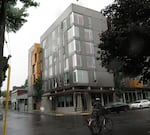New multi-unit apartments are popping up all over Portland at a breakneck pace. Turns out, they are not all created equal.

Lower Burnside Lofts, designed by Vallaster Corls Architects PC
April Baer / OPB
State of Wonder columnist-in-residence Randy Gragg agreed to show us around and talk about infill development and design, with a focus on one building loaded with nuanced design: the Lower Burnside Lofts at SE 10th and Ankeny streets.
Its structure is a simple box clad in deeply ribbed, copper-hued steel, marked by bright, caution-sign yellow balconies. It nicely suits the Central Eastside’s industrial character while appealing to the new knowledge economy.
It was brought to life by Don Vallaster, a founding partner of Vallaster Corl Architects. He's worked on infill housing for more than 20 years.
So what defines the line between a well-designed building and one where time and resources didn't allow for an in-depth design process?
Gragg explained, “For some [architects] it’s about the fit, both in the neighborhood and wider city’s context. For others, a good building is about efficiency — how many they can design while expending least amount of effort for the most money.”
In the case of Vallaster's Lower Burnside project, the target demographic was younger, millennial, educated, creative and about 60 percent male.
“My thought is that 20-year-olds are trying to escape the suburbs," Vallaster said. "Suburbs are carpet and sheet rock. They’re looking for a kind of authentic feel of the city."
With that in mind, Vallaster explained his team worked up a simple design that fit with the gritty texture of the streetscape.
“We can get some richness on the texture of the building by varying the rib panels as we go from floor to floor, and side-by-side panels also, so it doesn’t look like one simple monolithic building,” Vallaster said.
The colors weren't a special custom job, Vallaster said, but by choosing off-the-shelf colors, mixing them among the ribs, offset by vibrant, yellow balconies his team saw an opportunity to provide some variety to the building.
“We could just, by using color very carefully, and judiciously, enliven the building — to give a sense of randomness. And not too much color. We didn’t want to overdo it. Just do it minimally,” Vallaster said.
While the fees architects receive for designing a building can vary, the rents a finished building can command don't always correspond to money and energy invested in design.
“There’s longevity also, and lower maintenance by doing it right," Vallaster points out. "You’d like to see there be a premium for higher quality design and construction. We don’t always see that."
With new buildings continuing to cover Portland, and no end to the infill developments in sight, thoughtful planning and leadership remain essential.
“I think having the right developer really helps. Someone who is sensitive to the neighborhood they’re in and want to enhance it. That’s critical, Vallaster said.
Gragg mentioned that the current apartment boom serving millennials also occurred not so long ago in Portland’s recent past.
"It reminds me of the boom in the '70s that served the Boomers. Dozens and dozens of houses in southeast Portland were torn down for pretty uninspired multiplexes," Gragg said.
Many of those buildings were developed and maintained by one investor — Joe Weston. While new buildings like the Lower Burnside Lofts frequently sell for millions upon completion, an older generation of buildings stayed in Weston's hands. His stewardship of real estate holdings — ultimately passed on as assets to the Oregon Community Foundation — stand as a case study in what values infill development might come to represent over time.